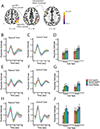Learning Cognitive Flexibility: Neural Substrates of Adapting Switch-Readiness to Time-varying Demands
- PMID: 38010299
- PMCID: PMC10902878
- DOI: 10.1162/jocn_a_02091
Learning Cognitive Flexibility: Neural Substrates of Adapting Switch-Readiness to Time-varying Demands
Abstract
An individual's readiness to switch tasks (cognitive flexibility) varies over time, in part, as the result of reinforcement learning based on the statistical structure of the world around them. Consequently, the behavioral cost associated with task-switching is smaller in contexts where switching is frequent than where it is rare, but the underlying brain mechanisms of this adaptation in cognitive flexibility are not well understood. Here, we manipulated the likelihood of switches across blocks of trials in a classic cued task-switching paradigm while participants underwent fMRI. As anticipated, behavioral switch costs decreased as the probability of switching increased, and neural switch costs were observed in lateral and medial frontoparietal cortex. To study moment-by-moment adjustments in cognitive flexibility at the neural level, we first fitted the behavioral RT data with reinforcement learning algorithms and then used the resulting trial-wise prediction error estimate as a regressor in a model-based fMRI analysis. The results revealed that lateral frontal and parietal cortex activity scaled positively with unsigned switch prediction error and that there were no brain regions encoding signed (i.e., switch- or repeat-specific) prediction error. Taken together, this study documents that adjustments in cognitive flexibility to time-varying switch demands are mediated by frontoparietal cortex tracking the likelihood of forthcoming task switches.
© 2023 Massachusetts Institute of Technology.
Figures







Similar articles
-
Dynamic Trial-by-Trial Recoding of Task-Set Representations in the Frontoparietal Cortex Mediates Behavioral Flexibility.J Neurosci. 2017 Nov 8;37(45):11037-11050. doi: 10.1523/JNEUROSCI.0935-17.2017. Epub 2017 Oct 2. J Neurosci. 2017. PMID: 28972126 Free PMC article.
-
Switch-Independent Task Representations in Frontal and Parietal Cortex.J Neurosci. 2017 Aug 16;37(33):8033-8042. doi: 10.1523/JNEUROSCI.3656-16.2017. Epub 2017 Jul 20. J Neurosci. 2017. PMID: 28729441 Free PMC article.
-
Neural Dynamics of Context-sensitive Adjustments in Cognitive Flexibility.J Cogn Neurosci. 2022 Feb 1;34(3):480-494. doi: 10.1162/jocn_a_01813. J Cogn Neurosci. 2022. PMID: 35015871 Free PMC article.
-
Minimal impact of consolidation on learned switch-readiness.J Exp Psychol Learn Mem Cogn. 2021 Oct;47(10):1622-1637. doi: 10.1037/xlm0001074. Epub 2021 Oct 25. J Exp Psychol Learn Mem Cogn. 2021. PMID: 34694824 Free PMC article.
-
The many faces of preparatory control in task switching: reviewing a decade of fMRI research.Hum Brain Mapp. 2013 Jan;34(1):12-35. doi: 10.1002/hbm.21420. Epub 2011 Oct 14. Hum Brain Mapp. 2013. PMID: 21998090 Free PMC article. Review.
Cited by
-
Modeling of control over task switching and cross-task interference supports a two-dimensional model of cognitive stability and flexibility.Psychon Bull Rev. 2025 Jun 2:10.3758/s13423-025-02712-7. doi: 10.3758/s13423-025-02712-7. Online ahead of print. Psychon Bull Rev. 2025. PMID: 40457159 Review.
-
Mapping common and distinct brain correlates among cognitive flexibility tasks: concordant evidence from meta-analyses.Brain Imaging Behav. 2025 Feb;19(1):50-71. doi: 10.1007/s11682-024-00921-7. Epub 2024 Oct 29. Brain Imaging Behav. 2025. PMID: 39467932 Free PMC article.
-
Category-like representation of statistical regularities allows for stable distractor suppression.Front Psychol. 2025 Aug 6;16:1598594. doi: 10.3389/fpsyg.2025.1598594. eCollection 2025. Front Psychol. 2025. PMID: 40842602 Free PMC article.
-
Serial processing of stimulus identity and shift readiness predictions.Atten Percept Psychophys. 2025 Aug 5. doi: 10.3758/s13414-025-03137-z. Online ahead of print. Atten Percept Psychophys. 2025. PMID: 40764877
-
Learned saccade readiness varies with fluctuations in sustained attention.Sci Rep. 2025 Aug 23;15(1):31058. doi: 10.1038/s41598-025-14340-1. Sci Rep. 2025. PMID: 40849309 Free PMC article.
References
-
- Allport DA, Styles EA, & Hsieh S (1994). Shifting intentional set: Exploring the dynamic control of tasks. In Umiltà C & Moscovitch M (Eds.), Attention and performance 15: Conscious and nonconscious information processing. (1994-98352-017; pp. 421–452). The MIT Press.
Publication types
MeSH terms
Grants and funding
LinkOut - more resources
Full Text Sources
Research Materials

